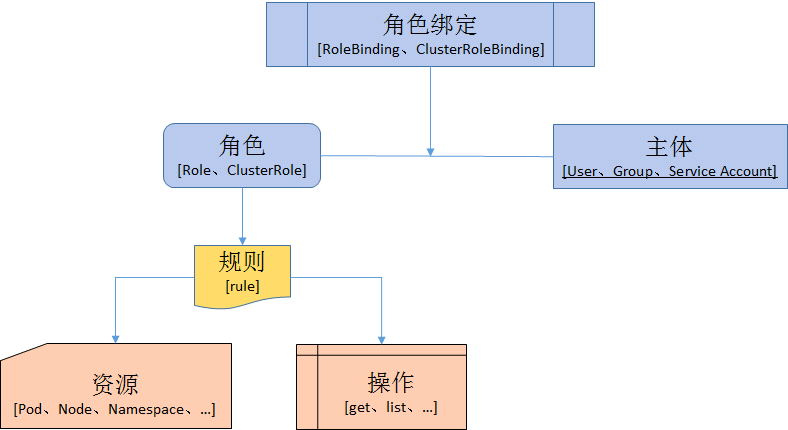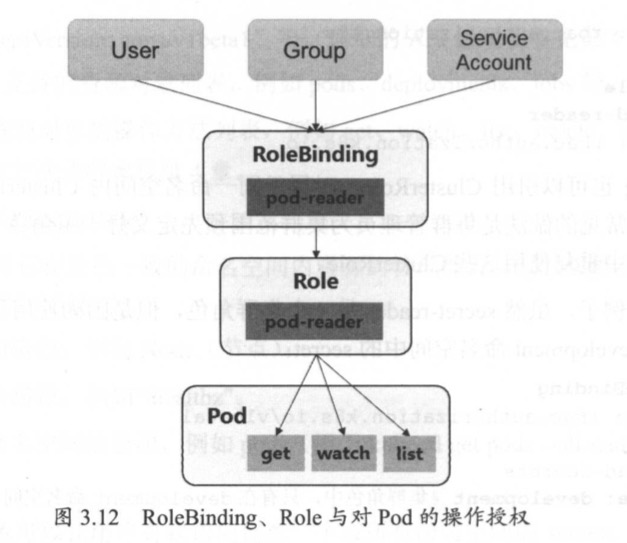k8s在启用基于角色管理的访问控制 RBAC(Role-based-Access-Control)的授权模式。相当于基于属性的访问控制ABAC(Attribute-based Access Control),RBAC主要是引入了 角色(Role 权限的集合) 和角色绑定(RoleBinding)的抽象概念。在ABAC中,k8s集群中的访问策略只能跟用户直接关联;而RBAC中,访问策略可以跟某个角色关联,具体的用户再和某个角色或者多个角色关联。
RBAC有四个新的k8s顶级资源对象: 角色(Role)、集群角色(ClusterRole)、角色绑定(RoleBinding)、集群角色绑定(ClusterRoleBinding)。同其他API资源对象一样,用户可以使用kubectl或者API调用方式等操作这些资源对象

RBAC具有如下优势
- 对集群中的资源和非资源权限有完整的覆盖
- 整个RBAC完由几个API对象完成,同其他API对象一样,可以使用kubectl 或API进行操作
- 可以在运行时进行调整,无须重新启动API server
- 使用RBAC授权模式,则需要在API sever的启动参数中 加上 --authorization-mod=RBAC。
角色(Role)
一个角色就是一组权限的集合,这里的权限都是许可形式的,不存在拒绝的规则。在一个名称空间(namespace)中,可以用角色来定义一个角色,如果是集群级别的,就需要使用ClusterRole了,角色只能对指定名称空间内的资源进行授权,下面例子中定义的角色具备读取pod的权限
kind: Role apiVersion: rbac.authorization.k8s.io/v1beta1 metadata: namespace: default name: pod-reader rules: - apiGroups: [""] # ""空字符串,表示核心API群 resources: ["pods"] verbs: ["get", "watch", "list"]
rules中的参数说明:
- apiGroups:支持的API组列表,如“apiVersion: batch/v1"、"apiVersion: extensions:v1beta1"、"apiVersion:apps/v1beta1"等。
- resources: 支持的资源对象列表,如pods、deployments、jobs等
- verbs: 对资源对象的操作方法列表,如 get、watch、list、delete、replace、patch等
集群角色(ClusterRole)
集群角色除了具有和角色(role)一致的名称空间内资源的管理能力,因其集群级别的生效范围,还可以用于以下特殊元素的授权管理上:
- 集群范围的资源,如node
- 非资源型的路径,如‘/healthz’
- 包含全部名称空间的资源,如pods(用于kubectl get pods --all-namespaces这样的操作授权)
下面的集群角色可以让用户有权限访问任意一个或所有名称空间的secrets:
kind: ClusterRole apiVersion: rbac.authorization.k8s.io/v1beta1 metadata: # ClusterRole不受限于命名空间,所以省略了namespace name的定义 rules: - apiGroups: [""] resources: ["secrets"] verbs: ["get", "watch", "list"]
角色绑定(RoleBinding)和 集群角色绑定(ClusterRoleBinding)
角色绑定或集群角色绑定 用来把一个角色绑定到一个目标(用户)上,绑定的目标可以是User(用户)、Group(组)、ServiceAccount。使用RoleBinding可以为某一个名称空间授权,使用ClusterRoleBinding可以为集群范围内授权。
RoleBinding可以引用Role进行授权,如下中的RoleBinding将在defalut名称空间中把pod-reader角色授予用户jane,这一操作让jane用户可以读取到default名称空间中的pod
kind: RoleBinding apiVersion: rbac.authorization.k8s.io/v1beta1 metadata: name: read-pods #RoleBinding名称 namespace: default #授予的名称空间 subjects: - kind: User name: jane #授权用户 apiGroup: rbac.authorization.k8s.io roleRef: kind: Role name: pod-reader apiGroup: rbac.authorization.k8s.io
RoleBinding 也可以引用ClusterRole进行授权
RoleBinding可以引用ClusterRole,对属于同一命名空间内 ClusterRole定义的资源主体进程授权。一种很常用的做法就是集群管理员为集群范围预定义好一组角色(ClusterRole),然后在多个名称空间中应用这些ClusterRole。这样可以提高授权管理工作效率,也使得各个名称空间下基础性授权规则与使用体验保持一致。
如下,虽然secret-reader是一个集群角色,但是因为使用了RoleBinding,所以dave只能读取development名称空间中的secret
kind: RoleBinding apiVersion: rbac.authorization.k8s.io/v1beta1 metadata: name: read-secrets namespace: development # 集群角色中,只有在development命名空间中的权限才能赋予dave subjects: - kind: User name: dave apiGroup: rbac.authorization.k8s.io roleRef: kind: ClusterRole name: secret-reader apiGroup: rbac.authorization.k8s.io
ClusterRoleBinding 集群角色绑定中角色只能是集群角色,用于进行集群级别或者对所有名称空间(all-namespaces)都生效的授权。如 允许manager组的用户读取任意namespace中的secret:
kind: ClusterRoleBinding apiVersion: rbac.authorization.k8s.io/v1beta1 metadata: name: read-secrets-global subjects: - kind: Group name: manager apiGroup: rbac.authorization.k8s.io roleRef: kind: ClusterRole name: secret-reader apiGroup: rbac.authorization.k8s.io
下图展示了上述对Pod的get/watch/list操作进行授权的Role和RoleBinding逻辑关系。

对资源的引用方式
多数资源可以用其名称的字符串来表达,也就是Endpoint中的URL相对路径,例如pods。然而,某些k8s API包含下级资源,如pod的日志(logs)。pod日志的Endpoint是GET/api/v1/namespaces/{namespace}/pods/{pod_name}/log。
在这个例子中,Pod是一个命名空间内的资源,log就是一个下级资源。要在RBAC角色中体现,则需要用斜线 '/' 来区隔资源和下级资源。
若想授权让某个主体同时能够读取Pod和 Pod log,则可以配置resources为一个数组:
kind: Role apiVersion: rbac.authorization.k8s.io/v1beta1 metadata: namespace: default name: pod-and-pod-logs-reader rules: - apiGroups: [""] resources: ["pods", "pods/log"] verbs: ["get", "list"]
资源还可以通过名称(ResourceName) 进行引用(这里指的是资源实例的名字)。在指定ResourceName后,使用get、delete、update、patch动作的请求,就会被限制这个资源实例的范围内。
如 声明让一个主体只能对一个configmap进行get 和update操作
kind: Role apiVersion: rbac.authorization.k8s.io/v1beta1 metadata: namespace: default name: configmap-updater rules: - apiGroups: [""] resources: ["configmap"] resourceNames: ["my-configmap"] verbs: ["update", "get"]
resourceName 这种用法对list、watch、create、deletecollection操作是无效的,这是因为必须要通过URL进行鉴权,而资源名称在list、watch、create和deletecollection请求中只能请求Body数据的一部分。
常用的角色(Role)实例
- 允许读取核心API组中的Pod资源
rules: - apiGroups: [""] resources: ["pods"] verbs: ["get", "list", "watch"]
- 允许读写"extensions"和"apps"两个API组中的"deployments"资源
rules: - apiGroups: ["extensions", "apps"] resources: ["deployments"] verbs: ["get", "list", "watch", "create", "update", "patch", "delete"]
- 允许读取"pods"及读写"jobs"
rules: - apiGroups: [""] resources: ["pods"] verbs: ["get", "list", "watch"] - apiGroups: ["batch", "extensions"] resources: ["jobs"] verbs: ["get", "list", "watch", "create", "update", "patch", "delete"]
- 允许读取一个名为"my-config"的ConfigMap(必须绑定到一个RoleBinding来限制到一个namespace下的ConfigMap)
rules: - apiGroups: [""] resources: ["configmaps"] resourceNames: ["my-config"] verbs: ["get"]
- 读取核心组的"node"资源(Node属于集群级的资源,所以必须存在于ClusterRole中,并使用ClusterRoleBinding进行绑定)
rules: - apiGroups: [""] resources: ["pods"] verbs: ["get", "list", "watch"]
- 允许对非资源端点/healthz及其所有子路径进行GET和POST操作(必须使用ClusterRole和ClusterRoleBinding)
rules: - nonResourceURLs: ["/healthz", "/healthz/*"] verbs: ["get", "post"]
常用的角色绑定(RoleBinding)示例
注意,下面的例子中只包含subjects部分的内容。
- 用户名"alice@example.com"
subjects: - kind: User name: "alice@example.com" apiGroup: rbac.authorization.k8s.io
- 组名"frontend-admins"
subjects: - kind: Group name: "frontend-admins" apiGroup: rbac.authorization.k8s.io
- kube-system命名空间中的默认Service Account
subjects: - kind: ServiceAccount name: default namespace: kube-system
- "qa"命名空间中的所有Service Account
subjects: - kind: Group name: system:serviceaccounts:qa apiGroup: rbac.authorization.k8s.io
- 所有Service Account
subjects: - kind: Group name: system:serviceaccounts apiGroup: rbac.authorization.k8s.io
- 所有认证用户(v1.5版本以上)
subjects: - kind: Group name: system:authenticated apiGroup: rbac.authorization.k8s.io
- 所有未认证用户(v1.5版本以上)
subjects: - kind: Group name: system:unauthenticated apiGroup: rbac.authorization.k8s.io
- 全部用户(v1.5版本以上)
subjects: - kind: Group name: system:authenticated apiGroup: rbac.authorization.k8s.io - kind: Group name: system:unauthenticated apiGroup: rbac.authorization.k8s.io
默认的角色和角色绑定
API Server创建了一系列的默认ClusterRole和ClusterRoleBinding对象,其中许多对象已“system:”前缀开头,代表其中绑定的资源作为基础设施适用和占有的,修改这些资源会导致整个集群不可用。一个例子是system:node ClusterRole角色拥有一系列的kubelet权限,如果这个集群角色被修改了,可能会让kubelet异常
所有默认的集群角色(ClusterRole) 和其角色绑定(role binding)都带有如下标记
kubernetes.io/bootstrapping=rbac-defaults
对系统角色的说明如下表所示
| 默认的ClusterRole | 默认的ClusterRoleBinding | 描述 |
| system:basic-user | system:authenticated和system:unauthenticated组 | 让用户能够读取自身的信息 |
| system:discovery | system:authenticated和system:unauthenticated组 | 对API发现Endpoint的只读访问,用于API级别的发现和协商 |
对用户角色的说明如下表所示:
| 默认的ClusterRole | 默认的ClusterRoleBinding | 描述 |
| cluster-admin | system:masters组 | 让超级用户可以对任何资源执行任何操作。如果在ClusterRoleBinding中使用,则影响的是整个集群的所有namespace中的任何资源;如果使用的是RoleBinding,则能控制这一绑定的namespace中的资源,还包括namespace本身。 |
| cluster-status | None | 可以对基础集群状态信息进行只读访问。 |
| admin | None | 允许admin访问,可以限制在一个namespace中使用RoleBinding。如果在RoleBinding中使用,则允许对namespace中大多数资源进行读写访问,其中包含创建角色和角色绑定的能力。这一角色不允许操作namespace本身,也不能写入资源限额。 |
| edit | None | 允许对命名空间内的大多数资源进行读写操作,不允许查看或修改角色,以及角色绑定。 |
| view | None | 允许对多数对象进行只读操作,但是对角色、角色绑定及secret是不可访问的。 |
注:有些默认角色不是以"system:" 为前缀的,这部分角色是针对用户的,其中包含超级用户角色(cluster-admin),有的用于集群一级的角色(cluster-status),还有针对namespace的角色(admin、edit、view)
对核心Master组件角色的说明如下表所示:
转载地址:https://www.orchome.com/1308
作者:半兽人
链接:https://www.orchome.com/1308
来源:OrcHome
著作权归作者所有。商业转载请联系作者获得授权,非商业转载请注明出处。
| 描述 |
|---|